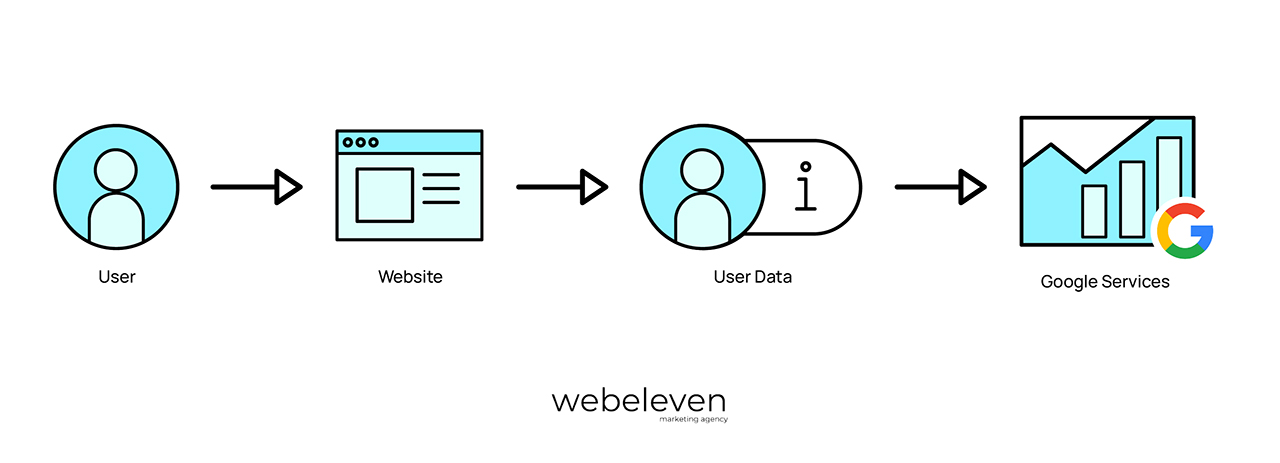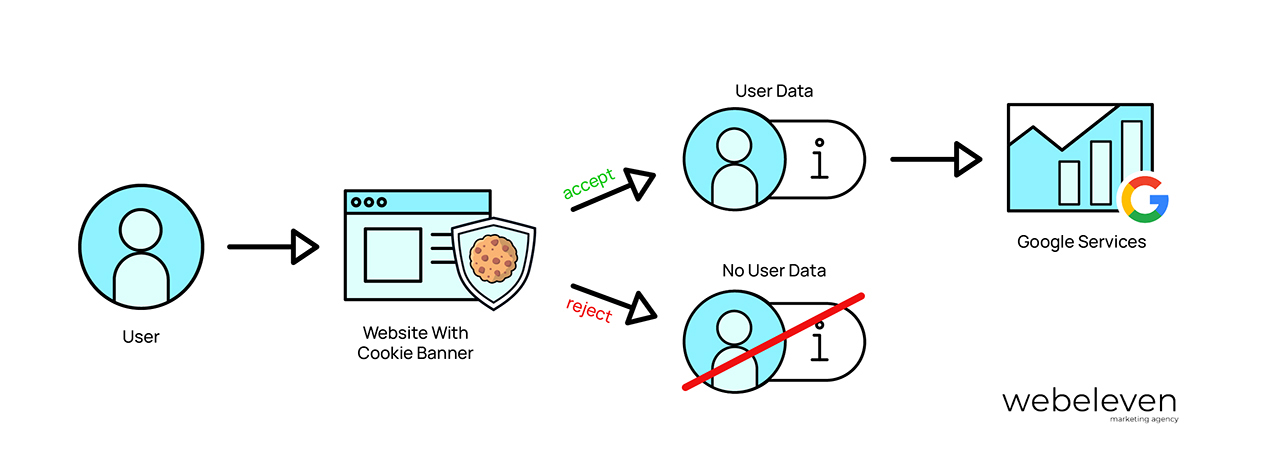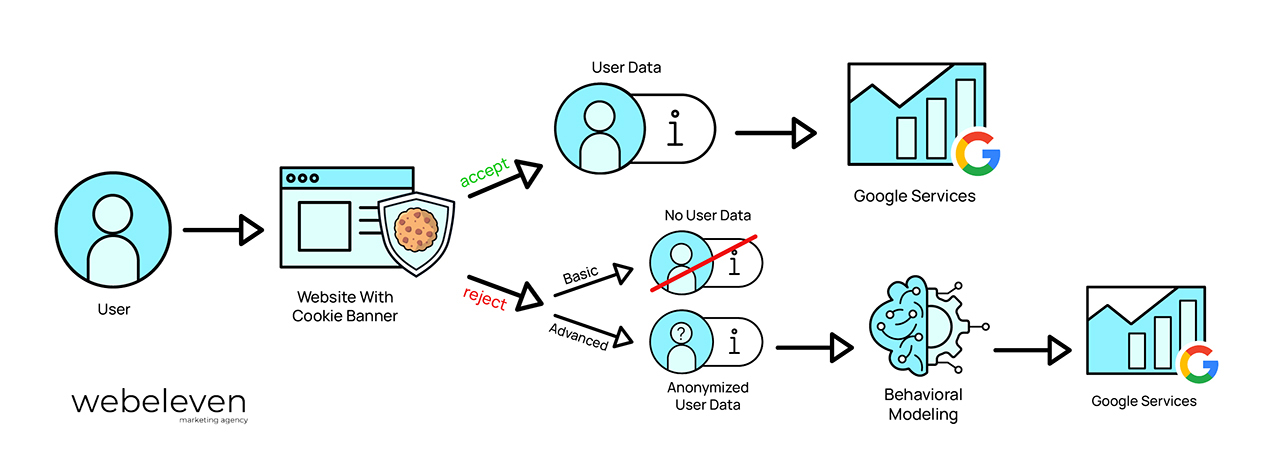Google Consent Mode V2: Balancing privacy and marketing

5 min read
In today’s digital landscape, user privacy and data protection have become central concerns for businesses and consumers alike. With increasing regulations such as GDPR and growing user awareness of how their data is being collected and used, it’s imperative for businesses to adapt their digital marketing strategies accordingly. Google recently introduced Consent Mode V2, an enhanced framework designed to help businesses manage user consent for tracking and data collection while maintaining effective analytics and advertising performance.
This updated version of Consent Mode builds on Google’s commitment to ensuring that advertisers can comply with data privacy laws without sacrificing valuable insights. By allowing websites to dynamically adjust Google tags (e.g. Google Analytics, Google Ads) based on the user’s consent status, Google Consent Mode V2 offers a more flexible, privacy-first approach to data collection. In this article, we will explore how this updated tool works, its key features, and why it’s a game-changer for businesses operating in the era of heightened data privacy.
Risks of data collection without consent mechanisms

In cases where consent checks are not implemented at all or are configured incorrectly (yes, you read that right, consent check is not done by simply installing a cookie banner plugin on your site 🤯), websites automatically collect data from users without asking for their consent. This approach can expose businesses to significant risks, particularly in regions governed by strict data privacy laws like GDPR or CCPA. Without consent checks, tools like Google Analytics or Google Ads tags are triggered immediately, tracking user behavior and gathering personal data without the user’s explicit permission. While this may provide continuous, uninterrupted data for analytics and marketing, it can lead to legal penalties, loss of user trust, and reputational damage if privacy regulations are violated. This highlights the importance of implementing proper consent mechanisms to ensure compliance and transparency.
How data collection works without Google Consent Mode V2

Without Google Consent Mode V2, when a user visits a website, their consent for tracking and data collection is typically managed through cookie banners or consent management platforms (CMPs). If a user declines to consent, Google tags such as those used for Google Ads or Google Analytics will be entirely disabled, meaning no data is collected or tracked. This results in gaps in analytics and advertising performance data, as the user’s actions on the site are not recorded. In cases where consent is not given, businesses lose crucial insights about site traffic, user behavior, and campaign effectiveness, making it difficult to optimize digital strategies while complying with privacy regulations like GDPR.
How Google Consent Mode V2 works

Google Consent Mode V2 is a solution designed to help businesses balance user privacy with the need for valuable data insights. Unlike the earlier version, Consent Mode V2 dynamically adjusts how Google tags behave based on the implemented mode (Basic or Advanced) and the consent status provided by each user.
Basic Mode
- When a user grants consent, data collection functions normally, enabling tracking for analytics and marketing purposes.
- When a user declines consent, tracking tags are completely disabled.
Advanced Mode
- When a user grants consent, data collection functions normally, enabling tracking for analytics and marketing purposes.
- When a user declines consent, instead of completely disabling tracking tags, Consent Mode V2 sends anonymized signals (cookieless pings) to Google services. In this case, GA4 (Google Analytics 4) follows a process called behavioral modeling for consent mode, which uses machine learning to model and estimate the behavior of users who reject cookies based on the behavior of similar users who accept cookies. This ensures compliance with privacy regulations while still providing some level of insight into website performance and user behavior, reducing the data gaps caused by users opting out. With its more flexible and privacy-focused framework, Consent Mode V2 offers a win-win for both users and businesses in the privacy-conscious digital environment.
What happens if Google Consent Mode V2 is not activated?
Google Consent Mode V2 is especially important and mandatory for companies targeting users in the European Economic Area (EEA). Without it, as Google has announced, from March 2024 onwards, no data on new EEA users will be captured by advertising platforms like Google Ads and Google Analytics 4 (GA4). As a result, without it, you will not be able to effectively keep using measurement, reporting, ad personalization, and remarketing features in the EEA. Additionally, your bidding algorithms will rely on incomplete and inaccurate data, leading to less effective budget spending.
Conclusions
In an increasingly privacy-conscious digital landscape, Google Consent Mode V2 offers a crucial solution for businesses to comply with data privacy regulations while maintaining effective analytics and advertising strategies. By allowing websites to adjust tracking behavior based on user consent, it ensures compliance with laws like GDPR and CCPA without sacrificing key insights. Whether users consent to full tracking or opt out, Consent Mode V2 allows businesses to continue gathering anonymized data, optimizing advertising performance, and filling data gaps through behavioral modeling. Implementing this tool not only protects user privacy but also enables companies to make informed decisions, optimize marketing campaigns, and use their budget more effectively in a privacy-first environment.
How can we help you face these challenges?
Google Consent Mode V2 is a significant change in the way websites collect data. At Webeleven, we understand the challenges that arise from the changes that are constantly occurring, and we have the expertise to help you adapt to these changes. We are here to ensure that your website continues to operate effectively and efficiently while protecting the privacy of your users. Contact us today to check if your website complies with GDPR regulations as well as if it follows the new Google Consent Mode V2 standard.